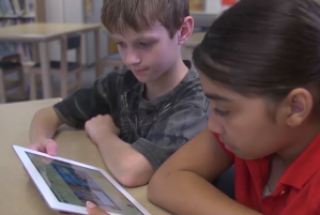Balancing Digital and Print in Library Collections
Special thanks to Spencer Hanson for the following post!
How libraries incorporate eBooks into their established print collections has been an ongoing experiment. It has only been since 2010 that a significant amount of school libraries have started offering eBooks. The Sixth Annual Survey of eBook Usage in U.S. School (K-12) libraries found the percentage of US schools offering eBooks has remained between 50-60% the past three years. Of the schools reporting that they have no eBooks in their library, “11% say they have no plans to ever offer them, although 9% say they definitely will add them in the next two years” (Romano, 2015, p. 7). Schools surveyed reported the greatest barrier to using eBooks in the library has been the availability of devices to read with and money to purchase eBooks followed by a lack of student demand and awareness of eBooks (Romano, p. 18).
 School libraries can improve the utilization of their eBooks by allowing students to check out tablets, demonstrating how to check out eBooks, and by working with teachers to make it easy to incorporate eBooks into lesson plans. Unfortunately 54% of schools with eBooks have “no coordinated strategy for eBook use [with] the curriculum” (Romano, 2015, p. 24). Student demographics are also changing, and the first cohort to have been born after the wide availability of tablets and smartphones are starting elementary school. Pearson conducted a 2014 survey of students and found that although students in high school use smartphones regularly, only 42% use tablets regularly (Pearson, 2015). However, 58% of middle students and 66% of elementary school students regularly use tablets (Pearson, 2015). Many of these students are already using tablets to do school work, and their greater exposure to eBooks may make them more comfortable with digital reading than previous students.
School libraries can improve the utilization of their eBooks by allowing students to check out tablets, demonstrating how to check out eBooks, and by working with teachers to make it easy to incorporate eBooks into lesson plans. Unfortunately 54% of schools with eBooks have “no coordinated strategy for eBook use [with] the curriculum” (Romano, 2015, p. 24). Student demographics are also changing, and the first cohort to have been born after the wide availability of tablets and smartphones are starting elementary school. Pearson conducted a 2014 survey of students and found that although students in high school use smartphones regularly, only 42% use tablets regularly (Pearson, 2015). However, 58% of middle students and 66% of elementary school students regularly use tablets (Pearson, 2015). Many of these students are already using tablets to do school work, and their greater exposure to eBooks may make them more comfortable with digital reading than previous students.Still school librarians should not view eBooks as displacing print’s importance in their collections. Instead, a blended collection is the way forward as print and digital each have their own advantages and drawbacks. Their position to one another is similar to hand writing versus typing, which are both necessary skills. Students still like the tactile experience of print that is lost with e-readers, but eBooks offer convenience and remote access that would be impossible with print. Furthermore digital books allow for enhancements not possible in print to improve the learning experience, and eBooks can be incorporated into lesson plans and linked to digital grade-books.
Lerner Digital offers school libraries affordable multi-user access to Lerner’s eBook collection of 4,300 K-12 titles. Multi user allows every student to check out the same title with no limitations, which takes full advantage of the digital medium. Try Lerner Digital’s free trial.
Looking for a great opportunity to build both your print and digital library simultaneously? Check out our current promotion offering print versions of our new Bumba Books series FREE with purchase of the Interactive Book versions. Give your library or classroom the large colorful print books while enjoying the text highlighting, audio narration, and bonus features of the interactive eBooks. Early readers are drawn to this new series in any format. Each interactive book includes an implementation guide and teaching guide, so classroom integration is fun and easy!
References
Pearson. (2015). Study reveals students believe tablets are game changers. Educational Digest, 89(2), 62.
Romano, R. (2015). Survey of eBook usage in U.S. school (K-12) libraries: Sixth annual survey. School Library Journal, 1-132.

